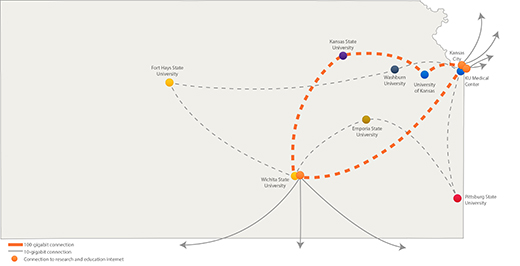HyperCore is coming: Network upgrade offers enhanced research capacity to state's universities
Wednesday, June 15, 2016

An upgraded network and additional connections to the research and education internet will help researchers at Kansas State University and around Kansas manipulate and share big data, as well as better compete for grant funds | Download this photo.
MANHATTAN — Brad Olson is interested in a big question: How did single-celled organisms evolve into more complex organisms? The assistant professor of biology at Kansas State University has turned to algae genomes to help him uncover clues to this question.
But sequencing and comparing algae genomes generates data — a lot of data. One project that prompted a major publication and national press coverage for Olson and his collaborators produced 10 terabytes of data. A terabyte is approximately 1 trillion bytes, or 1,000 gigabytes, which is equivalent to the total amount of storage in about 50 top-end iPads or 10 top-end laptops.
Manipulating 10 terabytes of data is a challenge, but sending the data to colleagues at other institutions is even trickier. Past solutions — even just a few months ago — entailed shipping boxes full of hard drives.
An infrastructure upgrade at Kansas State University and other Kansas Board of Regents institutions is making data analysis and sharing faster and easier. A new 100 gigabit-per-second network known as the HyperCore is slated to come online this summer, replacing the 10 gigabit-per second backbone that connects Kansas State University, the University of Kansas, KU Medical Center and Wichita State University. The HyperCore also provides exit points to regional, national and international networks that constitute the high-performance research and education internet so researchers can share data with collaborators around the world.
Olson says the need to store, manipulate and share data has exploded.
"This is where science has gone," Olson said. "When I was a graduate student, we'd have a ZIP drive or a disk and maybe fill it up over the course of the Ph.D. Now we're doing 20,000-gene by 20,000-gene comparisons. It opens up the ability to answer questions we weren't able to even five years ago."
Geoff Morris, assistant professor of crop genetics at Kansas State University who focuses on sorghum, also needs the enhanced capacity. He and his team help breeding programs in the U.S. and Africa use genomics to improve crops. A project starting this summer will use unmanned aerial vehicles, or UAVs, to collect field images that will be used to monitor plant stress and predict yield. The new methods will help breeders develop higher-yielding and better-adapted varieties.
"We already depend on getting billions of data points from the genomics facility at KU Med," Morris said. "Now with the new field studies, we'll have even bigger datasets. We're going from students walking through the field with clipboards to UAVs collecting millions of images over the course of a season. Handling the data is a massive undertaking."
Olson and Morris work through Beocat, the research computing cluster at Kansas State University, to connect to KanREN Inc., a research and education network that serves Kansas universities and some public school districts and community colleges. KanREN, a nonprofit owned by the universities, has been in operation for 25 years and purchases fiber from telecommunications companies with long-term leases so researchers have access to the connections they require. Olson said the 100-gig technology is bleeding-edge even in Silicon Valley.
Cort Buffington, executive director of KanREN, agrees. "No one in the country will have better connectivity. This is the highest level you can get," he said.
The upgraded connection benefits research institutions, but it also helps regional universities in Kansas. Updated 10-gigabit infrastructure will remain in use for Fort Hays State University, Pittsburg State University, Emporia State University and Washburn University, and it will perform much better when traffic from Kansas State, KU, KU Med and Wichita State migrates to the new HyperCore.
The investment in 100-gig fiber will last five to seven years. When additional capacity is needed, KanREN can purchase more for a set price.
Dan Andresen, professor of computer sciences and director of the Institute for Computation Research in Engineering and Science at Kansas State University, oversees Beocat. He works with scholars on and off campus — including researchers at institutions in Canada and Vietnam as well as those closer to home at Bethany College and KU — and says the 100-gigabit connectivity will help Kansas State University compete and meet its goal to become a Top 50 research university by 2025.
"The move to 100-gig really will raise our competitiveness in terms of going after bigger grants and collaborations," Andresen said. "The next wave of research will analyze huge amounts of data from smart grids, the internet of things, and so on."
Morris said agriculture research is a major beneficiary.
"Funding agencies are asking for ambitious and transformative new approaches to agricultural research, and being able to show that Kansas State University can handle the data side of it is very important," he said. "This upgrade shows we're serious about making big data work for agriculture."
Necessary equipment upgrades began last year, and rollout of the 100-gig backbone has happened gradually this spring. The official "go-live" day is July 1. Kansas State University researchers can gain an optimized connection to the backbone by working with Andresen and Beocat. They also have the option of quickly adding capacity for individual projects when necessary for a fraction of the cost of deploying the HyperCore.
Olson's research demonstrates the power of manipulating data. In exploring how multicellular algae evolved, he and his collaborators gained insight into why cancer occurs. The network upgrade will help him push forward with more projects. He hopes to communicate why research matters to everyone.
"We're not just messing with weird networks and boxes whirring in the ceiling," Olson said. "We're improving life and agriculture."
